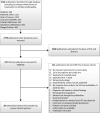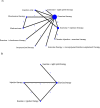Which treatment is most effective for patients with Achilles tendinopathy? A living systematic review with network meta-analysis of 29 randomised controlled trials
- PMID: 32522732
- PMCID: PMC7907558
- DOI: 10.1136/bjsports-2019-101872
Which treatment is most effective for patients with Achilles tendinopathy? A living systematic review with network meta-analysis of 29 randomised controlled trials
Abstract
Objective: To provide a consistently updated overview of the comparative effectiveness of treatments for Achilles tendinopathy.
Design: Living systematic review and network meta-analysis.
Data sources: Multiple databases including grey literature sources were searched up to February 2019.
Study eligibility criteria: Randomised controlled trials examining the effectiveness of any treatment in patients with both insertional and/or midportion Achilles tendinopathy. We excluded trials with 10 or fewer participants per treatment arm or trials investigating tendon ruptures.
Data extraction and synthesis: Reviewers independently extracted data and assessed the risk of bias. We used the Grading of Recommendations Assessment, Development and Evaluation to appraise the certainty of evidence.
Primary outcome measure: The validated patient-reported Victorian Institute of Sport Assessment-Achilles questionnaire.
Results: 29 trials investigating 42 different treatments were included. 22 trials (76%) were at high risk of bias and 7 (24%) had some concerns. Most trials included patients with midportion tendinopathy (86%). Any treatment class seemed superior to wait-and-see for midportion Achilles tendinopathy at 3 months (very low to low certainty of evidence). At 12 months, exercise therapy, exercise+injection therapy and exercise+night splint therapy were all comparable with injection therapy for midportion tendinopathy (very low to low certainty). No network meta-analysis could be performed for insertional Achilles tendinopathy.
Summary/conclusion: In our living network meta-analysis no trials were at low risk of bias and there was large uncertainty in the comparative estimates. For midportion Achilles tendinopathy, wait-and-see is not recommended as all active treatments seemed superior at 3-month follow-up. There seems to be no clinically relevant difference in effectiveness between different active treatments at either 3-month or 12-month follow-up. As exercise therapy is easy to prescribe, can be of low cost and has few harms, clinicians could consider starting treatment with a calf-muscle exercise programme.
Prospero registration number: CRD42018086467.
Keywords: Achilles tendon; efficacy; intervention; tendinopathy.
© Author(s) (or their employer(s)) 2021. Re-use permitted under CC BY-NC. No commercial re-use. See rights and permissions. Published by BMJ.
Conflict of interest statement
Competing interests: NJW led a research project in collaboration with Pfizer (project ended 31 December 2018). Pfizer part-funded a junior researcher. The projects were purely methodological, using historical data on pharmacological treatments for pain relief.
Figures





References
-
- de Vos RJ, D'Hooghe P, de Leeuw P, et al. . Chapter 19: Achilles tendinopathy. : The ankle in football. 1 edn. Paris: Springer-Verlag Paris, 2014: p213–33.
-
- Lagas IF, Tol JL, Weir A, et al. . One in four patients with midportion achilles tendinopathy has persisting symptoms after 10 years: a prospective cohort study. Am J Sports Med 2019.
Publication types
MeSH terms
Grants and funding
LinkOut - more resources
Full Text Sources
Medical
Research Materials
